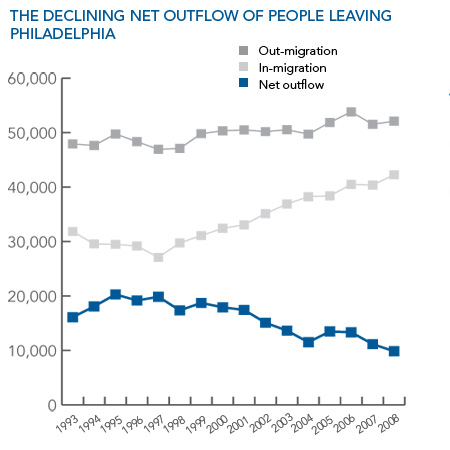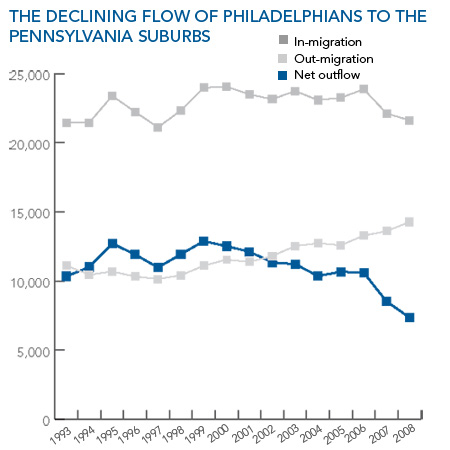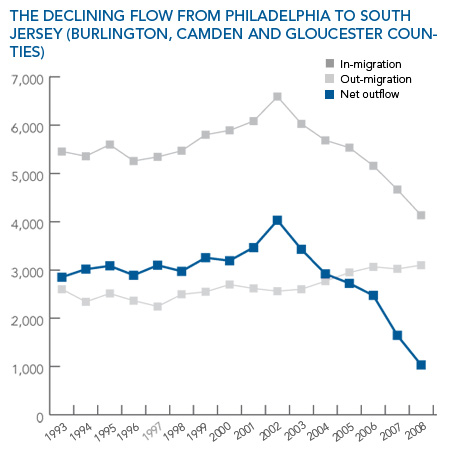Destination Philadelphia: Tracking the City's Migration Trends
An analysis of migration data from the Internal Revenue Service shows that the number of people moving into the city of Philadelphia has increased steadily in recent years, rising at a faster rate than the number of people moving out.
On balance, the city has been losing fewer people to other communities, especially the suburbs, reducing the magnitude of a six-decade-old trend that was at the heart of the city's long-term population decline.

These patterns in the IRS data, which track year-to-year address changes by individuals who have filed tax returns, lend support to recent estimates from the U.S. Census indicating that the city's population has increased slightly during the past decade.
To be sure, more people still are leaving Philadelphia than are arriving; that has been the case in each of the 16 years for which data was analyzed (1993 to 2008). But the net outflow, as recorded by the IRS, has decreased substantially in recent years, from a peak of 20,284 in 1995 to 9,846 in 2008, the last year for which data was available.
A modest net outflow in this data is not inconsistent with a growing population, particularly in a city such as Philadelphia where births outnumber deaths. The IRS data do not include the newly arrived foreign immigrants whose presence helps boost the city's population numbers.
Among the other findings of the analysis are these:
- The net outflow from Philadelphia to the four Pennsylvania suburban counties—Bucks, Chester, Delaware and Montgomery—was lower in 2008 than in any of the years studied, dropping to 7,352 from a peak of 12,595 in 1999, a decline of 42 percent.

- The drop in the net outflow from Philadelphia to the three suburban New Jersey counties—Burlington, Camden and Gloucester—was even more pronounced than for the Pennsylvania suburban counties. From its recent peak of 4,029 in 2002, the net outflow to South Jersey fell to 1,031 in 2008, down 74 percent. The movement of people from Philadelphia to those counties in 2008 was the lowest in the period studied, and the movement into the city was the highest.

- The overall churn in Philadelphia's population—the number of people coming and going—has been increasing in recent years and was 27 percent higher in 2008 than in 1997. Even so, the city has less population turnover from year to year than many other major urban jurisdictions. For Philadelphia, IRS data show the total number of people coming and going in 2008 amounted to 6.1 percent of the city's population. The median for 15 selected large urban jurisdictions, some of which are counties that include suburban areas, was 8.3 percent.
- Migration from New York City to Philadelphia more than doubled during the period, from 1,332 in 1993 to 3,100 in 2008, thereby supporting the notion that Philadelphia has become a haven for some New Yorkers priced out of that city. But the flow in the opposite direction increased sharply during the past few years, reducing the net in-flow from New York to only 212 in 2008.
About half of the movement of people in and out of Philadelphia involves locations within the metropolitan area. Outside the region, New York City, Los Angeles County, Cook County (Chicago) and Allegheny County (Pittsburgh) are high on the list of places to which Philadelphians move and from which they come, as is Puerto Rico. So, too, are several Florida counties, as well as counties in the northern New Jersey, Baltimore, Boston and Washington, DC, areas.
The IRS data understate actual migration numbers across the board because, in addition to excluding new foreign arrivals, they do not include people too poor to file tax returns.











